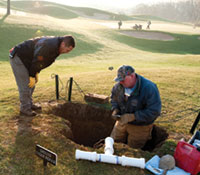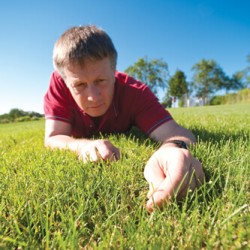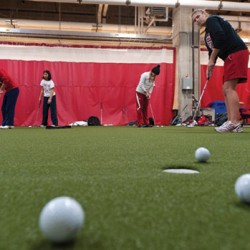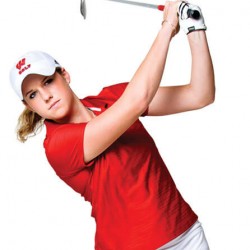Behind the Greens

At dawn in spring, Aron Hogden (left) and a member of the greens-keeping staff repair an irrigation line as part of maintenance work at University Ridge Golf Course. Photo: Jeff Miller
There’s a science to watching the grass grow.
Anyone who has watched a golf course go from crispy to lush knows it takes more than Mother Nature to keep greens green.
With its variable climate, Wisconsin isn’t kind to turfgrass. Big swings in spring moisture make life difficult for those who tend turf. “It’s not until things are growing that we can fully assess the toll that winter has taken on the course,” says Aron Hogden, superintendent at University Ridge Golf Course in Madison. “In early spring, we make plans to remedy any winter damage and get the course ready for play.”
Hogden oversees a full-time staff of five and a seasonal staff of twenty, including many UW students and retirees who tend to a recently expanded 7,259-yard course, a 33-acre practice facility for Badger golf teams, and a 60-acre cross-country course. “As soon as the seed is sown, we take responsibility for bringing it in,” Hogden says. “We create a surface that’s worth playing on.”
His own route to the job was fairly typical. Hogden started working on a golf course as a young man, loved it, and decided to make it his career. He studied turfgrass science at Ohio State — others enter the field with degrees in soil science, horticulture, agronomy, or plant pathology. “Because of the image of the greenskeeper with a piece of straw sticking out of his mouth and a pair of bib [overalls] on,” Hogden says, “there’s a real focus on promoting professionalism in this industry.”
The University Ridge staff works with an active team of UW-Madison researchers, including Doug Soldat from soil science; John Stier, horticulture; Chris Williamson, entomology; and Jim Kerns, plant pathology. “But hopefully not too often,” Hogden says, “because there’s usually a problem when we’re dealing with them.” The golf course also has a good relationship with the UW’s O.J. Noer Turfgrass Research and Education Facility. Located two miles away, Noer’s researchers compare turfgrass varieties, mowing practices, equipment, and strategies for fertilizer, irrigation, and pest management. In acreage, turfgrass is Wisconsin’s fifth biggest crop. “We try to provide them with an opportunity to do research on a live golf course,” Hogden says.
The course is open from April through October, but the greens-keeping crew works continually to enhance the land and reduce impact and water use. They recently committed to completing a five-year prairie restoration project and are in the process of earning certification from the Audubon Cooperative Sanctuary.
University Ridge’s expansion has improved the site’s marketability among student athletes and the general public. Wisconsin hosts the women’s Big Ten tournament in 2010, and hopes the course will attract other major NCAA and PGA tournaments.
Published in the Summer 2009 issue



Comments
No comments posted yet.